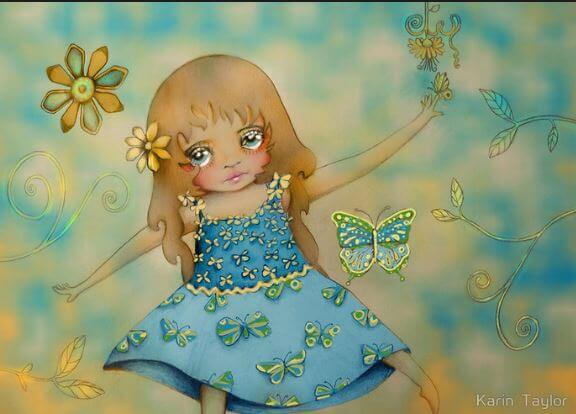Childhood Depression: A Child's Tears Are Bullets Straight to the Heart

Childhood depression exists, though it is little known. Sad children who cry, who don’t smile, who constantly get angry and who don’t enjoy life. Children who live their lives drowning in anguish. Children who see their innocence obscured by the terrible monster of depression.
Because ultimately yes, there are children who find themselves in a profound sadness. Children who cannot smile, because their reality has been responsible of pausing their innocence. It doesn’t seem real. Because the image that we maintain of childhood is that of children who are all smiling, happy and playful.
When we see a child who is serious and crestfallen, we strive to tell him that he shouldn’t be sad. We tell them to not cry, to smile. That is the first grave mistake.

Childhood depression: a depression with visible features
Childhood depression exists and has distinct signs that can help us set off an alarm that something is not right in the inner emotional life of our youngsters. Some of the symptoms are similar to the ones found in adults. For example, sadness manifests itself frequently, as well as the decline in academic performance. This is comparable to the low work performance seen in adults.
However, a distinctive aspect is that irritability and aggressiveness are common traits in childhood depression. Also, you tend to find somatic complaints such as stomach pains, headaches, muscle pains, etc.
We can also see how darkness clouds their motivation and their desire to play or do different activities. You may also see that the child doesn’t eat or sleep properly or how he suffers from a lack of overall energy.
A youngster who suffers of childhood depression is likely to not be able to concentrate, think or make decisions. In fact, he may experience thoughts of death or ideas, plans or attempts of suicide.
If you observe five or more of the cited symptoms, the specialist will probably make the diagnosis of childhood depression. Nevertheless, you have to keep in mind that certain states of apathy, reluctance or sadness are perfectly normal.

In fact, we should respect the apathy or sadness of a child with caution. We often insist on telling them to try to be happy without understanding what is causing their discomfort. This means that we will be transmitting the message that sadness, frustration and anger aren’t normal; that they are useless emotions.
Let’s think about what this implies for a child or an adult. Is being sad over a loss not normal? Do all of us not feel irritable at some point? Are these emotional states not useful for the realization of certain things?
It is also possible that we may observe certain motor agitation in depressed children, which is referred to as agitated depression. The child cannot remain seated calmly. It seems like the seat burns his skin. He wrings his hands, paces constantly, drums his fingers…

They seem to be running on a battery that is always fully charged. This state should not be confused with hyperactivity. Thus, it is always essential for professionals to observe any other symptom that may accompany this in other to make the correct diagnosis.
The counterpart of agitated depression can be seen in slow depression. This little one thinks, talks and moves in slow motion. You can’t talk to him, and you have to constantly repeat any questions made towards him. His topics are not varied, and he remains silent and still for very long periods of time.
Another clue can be when the child has a very low or poor self-concept or self-esteem. The child might think that he is worthless and is flawed by nature. He might even magnify the mistakes he makes.

10 ideas to help a depressive child feel better
Francisco Xavier Mendez, a Spanish childhood psychologist, offers within his book “The Child That Doesn’t Smile” ten ideas to promote smiles and joy in children who suffer from continued sadness.
- Teach by example: smile, show good humor, enjoy your free time and your vacations, think aloud in a sensible way, etc.
- Help the child have fun and feel well: program pleasant and fun activities, invite their friends to the house, surprise them with innovative and attractive plans, highlight their achievements, keep in mind their preferences.
- Safeguard them from unnecessary suffering: care for their health (vaccinations, hygiene, sleeping habits, nutrition, etc.), prepare them for stressful situations (the start of the school year or the loss of a family member, for example).
- Promote a harmonious environment within the family and home: manifest your love with words and actions, promote communication within the family, avoid having parental disputes in their presence, etc.
- Educate them with affection and coherence: behave according to the environment, establish reasonable behavioral rules and demand their compliance, be comprehensive and flexible, cooperate with their school, etc.

- Boost their qualities, hobbies and interests: enroll them in a gym or club, awaken their interest for reading, music, theater, film, collecting or gathering, crafts, etc. Encourage them to try out enriching experiences such as new flavors, sports, games…
- Train them to be able to handle frustration: don’t comply to their irrational demands, ignore their temper tantrums, teach them to wait for their turn, gradually delay the satisfaction of his deferred requests, progressively delay the gratification, make them share their toys and belongings.
- Make them responsible, not guilty: value the effort of their studying, not their grades or awards obtained. Set realistic goals and congratulate them for accomplishing them (“Congratulations on your grades!” is better than “I want to see all A’s next time!”).
- Mold a rational thinking style: avoid labels and absolutist language (“You are bad. You never do this”); Instead of facilitating the solution, make them think about it (“What could we do to resolve…? And what else?”). Talk with them, rebut their irrational ideas and beliefs, etc.
- Strengthen their autonomy: teach them basic skills such as how to bathe and clothe themselves, to cook or how to manage their money. Give them the opportunity to practice. Help them in everything they need, but don’t solve their problems for them. Gradually allow them to participate in the decision making process.
Nevertheless, if we see any of the symptoms cited above in a continuous manner, we should consult with a specialist to evaluate the child. They will work on the different aspects commented above. And this will shine a light on the fantastic smile that every child should show on their face and in their heart.
Children’s emotional health isn’t something that just appears by magic. It is something you have to cultivate. That is why we can’t forget that it is easier to raise strong children than to repair broken adults.
This text is provided for informational purposes only and does not replace consultation with a professional. If in doubt, consult your specialist.








